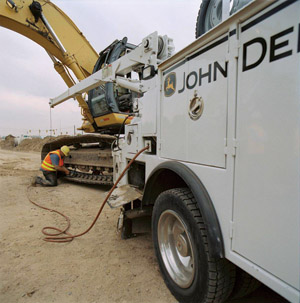
Maintenance: Condition-based maintenance
By Canadian Rental Service
Features Business IntelligenceHealthy equipment that runs efficiently and achieves top production is the hallmark of a profitable rental company. To achieve this goal, equipment must be effectively maintained at the least possible cost.
 |
| Condition-based maintenance is a system of proactive maintenance procedures that are based on monitoring the health of the machine to provide timely services based on that information. |
Healthy equipment that runs efficiently and achieves top production is the hallmark of a profitable rental company. To achieve this goal, equipment must be effectively maintained at the least possible cost. The following tips will help equipment fleet managers accomplish maximum productivity and uptime while minimizing costs.
Condition-based maintenance is exactly what it sounds like: proactive maintenance procedures that are based on the condition of the machine. To provide maintenance, the technician reads the health of the machine and provides services based on that information. The most powerful technique used in condition-based maintenance is a complete oil analysis.
“With many inferior oil analysis tests out there, it’s imperative to use one that will give you complete information,” says John Deere service marketing manager, Diego Navarro. “You should be able to analyze an oil sample and really read what’s going on with the machine.” Another technique commonly used in condition-based maintenance is root cause analysis, according to Navarro. “Any problem has three root causes,” he says. “One of them obviously is human error. For example, using the wrong kind of oil. Then there’s physical error, such as parts failure. Administrative error also can play a part, such as the lack of written procedures or failure to schedule inspections. In short, if you don’t find the reason the machine is failing, it will fail again. Root cause analysis helps us get to what is really causing the problem, so we can address it. It’s treating the disease instead of just relieving the symptoms.”
Particle counts and filtration
Filtration of the hydraulic system is important to extend the component life of any machine. The technician should initially determine the particle count by testing the fluid. Once that is done, a target particle count can be established and then filtration can take place to reach that target.
“An on-site filtration caddy can clean the hydraulics very fast while you’re performing other services,” he says. “You should be prepared for a range of filtration methods, including an on-site caddy, to help keep the equipment’s systems healthy and clean while on the job site. In some cases you may need to use bypass filtration, which is an aftermarket product. The bypass filter will take two or three weeks to reach that cleanliness.” Another technique, magnetic filtration, is effective for components such as axles. It is primarily used to capture iron particles. “Iron in big quantities damages bearings, oxidizes the oil and consumes the additive,” says Navarro. “When you change oils, not all the iron goes out, so it’s important to collect that iron using magnetic filtration.”
Proper lubrication
Lubricants are designed for a specific purpose, then are tested and developed with stringent quality control. During development, they are subject to a wide range of temperatures and pressures to determine how they will perform. As a result, mixing lubricants is a risk machine owners will not want to take.
“When your machine needs more oil and you simply add any product you find instead of sticking with what’s already being used in the machine, you are instantly changing the formulation,” he says. “This produces a new product that has not been tested and it can often affect the machine negatively by accelerate wear, as these two lubricants aren’t designed to work together. ”One negative reaction that mixing lubricants can cause is copper generation. Copper comes from bronze, which is an alloy used in many high pressure system pumps. If copper is being leached from the pump’s bronze, pump efficiency will suffer and contamination of the entire system and components also will occur. “If excess copper shows up in your oil analysis, you need to determine why the system is generating copper and fix the root problem,” he says.
One useful tool to maximize uptime and keep operating costs as low as possible is a system that allows for electronic machine monitoring. Machines with these types of systems can record up to 10,000 hours of operation information, from fuel consumption to pressures and temperature to percentage of use of such things like the arm, bucket and swing on a loader. “Machine information is vital to keeping costs in line,” he adds. “It helps you determine how much time your customers spend idling or working, or when operating the machine is wearing out components abnormally, it records just about everything about machine operation. The result is hours and hours of information that can really help the fleet supervisor manage cost and maintenance.”
Article courtesy of John Deere.
Print this page
Leave a Reply